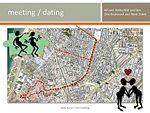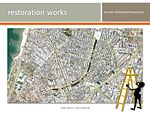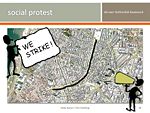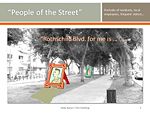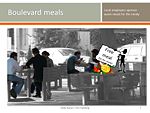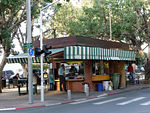Rothschild Boulevard
---> back to overview of Case Study List
Strolling along Tel Aviv's oldest and most famous boulevard and its surrounding
Short Introduction to the Area of Study
Rothschild Boulevard is one of the major streets in Tel Aviv, and certainly it’s most famous: As one of the city’s first four streets, it was built on top of sand dunes. First named Rehov Ha’Am (literally – the ‘Street of the people‘), it was changed to Sderot Rothschild in 1910, in honor of Baron de Rothschild, member of the French branch of the famous banking dynasty.
It was designed as a boulevard because the Jewish settlers were unable to drain the small wadi that ran there and were compelled to construct on both sides of the street, leaving the center for pedestrians, thus making it into the city’s first boulevard. It is here that the Independence Hall is located, the site where the first Israeli Prime Minister, David Ben Gurion, declared the establishment of the State of Israel, on the 14th of May, 1948.
Nowadays, the boulevard has a designated promenade for pedestrians and bicycle as its centerpiece; it is the financial center of Israel’s only metropolis, with the Tel Aviv Stock Exchange and all the head offices and branches of the big banks and brokerage houses. But it is also a culinary hotspot, with posh restaurants on either side of the boulevard and in adjacent streets; a café mecca that has trendy spots in and around the avenue; a nightlife center with nearby Lillinblum St. offering the city’s largest concentration of bars.
The boulevard starts in Neve Tsedek on its southwestern end and goes east, intersecting with Herzl and Allenby until it reaches the Habima National Theater. It’s one of the most expensive streets in TA, thanks to some beautiful structures that have been kept in excellent condition or have been carefully renovated, forming part of the White City recognized by UNESCO as World Heritage Site since 2003.
The boulevard is residential between Habima and Mazeh Street. Its most active (and expensive) part lies north of its intersection with Allenby Street. Many of the smaller streets connecting with Rothschild here have the same historical-yuppie atmosphere, architectural style and cultural significance. Thus, one should not just walk up and down Rothschild but stroll around in search for some “gems“. South of the Allenby intersection, business is less active but experts consider that area to be the boulevard's future as some luxury residential projects are planned for the area.
Exercise 1: Sketching the Landscape
Time frame: October 25 - November 15, 2011
Student activities:
- Creation of analytical drawings and sketches
- Presentation of results
Sketches and Drawings
- sketches
- sections
Exercise 2: Landscape Layers
Time frame: November 15 - 29, 2011
Tel Aviv was founded in 1909, the idea being to establish a Jewish garden suburb, located on the sand dunes north of Jaffa. Rothschild Boulevard was one of the first four residential streets. After World War I, a town-planning scheme for a garden city of 40,000 was prepared by Sir Patrick Geddes, which provided for small plots for family houses, with narrow peaceful streets, small public gardens and some major boulevards.
time based changes
"landscape biography"
- 1910-1920: sand cover, remnants of wadi in the center, planting of trees
- 1920-1930: construction of pedestrian walk to both street sides
- 1930-1940: addition of outdoor furniture, fences
- 1940-1960: construction of Founder's Square, pond
- 1960-1980: construction of playgrounds, implementation of open air art
- 1980-2000: implementation of bicycle lanes, new outdoor furniture
- 2000-2002: renovation
- since 2000: art exhibitions (globes, bulls etc.), construction of high-rising buildings, restauration of Bauhaus buildings
- summer 2011: implementation of bicycle rental spots, demonstration camp site
- historic pictures
People promenading on Rothschild Blvd and Herzl St, drawing by Nahum Gutman [1]
Tel Aviv's first kiosk on the corner of Rothschild Blvd / Herzl St, photo by Avraham Soskin, 1910 [2]
Rothschild Blvd and Herzl St, Tel Aviv, 1911 (to the southwest). Note the kiosk under the red arrow. [3]
Buildings under construction on Rothschild Blvd [4]
Rothschild Blvd towards Neve Tzedek neighborhood, 1921 [5]
Rothschild Blvd in the 1920s [6]
Rothschild Blvd in the 1930s [7]
Rothschild Blvd, 1947 [8]
- future development in the southern part
Future scenario of Rothschild Blvd until 2020 [9]
Model of Meier Tower on Rothschild Blvd / Allenby St (currently under construction) [10]
formal analysis
- topography, open spaces, built, green, traffic and water structures on different layers.
- Definition of zones with coherent character
- Description of this character.
- topography
- land use
Exercise 3: Behaviour Patterns
Time frame: December 6 - 20, 2011
- How do people behave in this area? How do they use the space? What is important for them?
- Observation of study area, interviews with local people and mapping of use patterns.
- Preparation of short presentation
The boulevard and its surrounding attract the young and the beautiful, the rich big spenders and the homeless, as well as parents with strollers or dog walkers with plastic bags or sports men and women. You can spend few lovely hours walking around, mixing a bit of people-watching, resting on one of the promenade's benches, sipping coffee or having business lunch in one of the cafés or restaurants.
In the afternoons and weekends you see children use the playing devices in the northern part towards Habima Theater. Around sunset you can watch elderly play Boule in the designated fields in the central area. In the late evenings you may find yourself listening to street artists who perform near Shabal St. around a sculpture built from a chair on a pyramid of stairs, all painted in green. Every early Sunday morning you can see municipal workers cleaning the pavement from fallen leaves and common litter.
- social activities
Exercise 4: Communication Concepts
Time frame: December 19, 2011 - January 17, 2012
- Based on the different landscape assessment approaches students will develop a communication concept for their area of study
- Which measures would be necessary for enhancing the awareness for the area?
- Students are free to choose their method.
“Street of the People // People of the Street”
The communication concept for Rothschild Blvd is based on the original name of the street, Rehov HaAm ("Street of the People"), and it refers to three specific social spaces. Each concept part, again, exists of two elements and includes several different communication "channels":
- 1: exhibition room
- strollology tours by residents (adults and kids)
- publication (incl. video clips introducing the guides) and registration through local website
- broadcasting also through local radio station "Radio Rothschild"
- portrait exhibition of residents, local employees, street artists, frequent visitors, homeless etc., stating their personal relation to the boulevard
- also visible at the local website (incl. video interviews of the portrayed people)
- 2: dining room
- local companies (restaurants, banks, etc.) sponsor warm meals for the needy
- publication through the local website, "Radio Rothschild" and social organisations
- residents invite neighbors, random visitors, tourists etc. for an open-air Shabbat dinner (or BBQ or picnic) with home-made food (summertime only)
- publication (incl. video (audio) clip introducing the hosts) and registration through local website and "Radio Rothschild"
- 3: play room
- sport events and children games
- publication (incl. sponsoring by local companies) and registration through local website and "Radio Rothschild"
- street concerts (free of charge) by famous and / or not yet famous local musicians, e.g. Coolooloosh “People of the Street“ (BalkanBeats), Street Music (HipHop), Perets Chayiut (FolkRock
- publication (incl. video clips of the artists) through local website
- live broadcasting also through local radio station "Radio Rothschild"
Image Gallery
References
- ↑ Sharon, Arieh (2011). Kibbutz + Bauhaus > Tel Aviv on the Mediterranean - A Town on Pilotis 1932-1939 > Tel Aviv's First Buildings > Picture 2 of 8: Drawing by Nahum Gutman http://www.ariehsharon.org/TelAviv/Tel-Avivs-First-Buildings/img003/1243297080_CKnRn-M.jpg (Nov 28, 2011)
- ↑ Jewish Heritage Online Magazine (2011). Arts > Documentators of the Dream > Avraham Soskin. Tel Aviv's water tower, and the first kiosk erected on the corner of Rothschild Boulevard and Herzl Street, 1910. Silver Prints Collection. http://jhom.com/arts/doc_dream/ill9_large.jpg (Nov 28, 2011)
- ↑ Heiss, Jerry (2011). 1911:Rothschild Blvd. and Herzl St. Tel Aviv http://www.flickr.com/photos/jerry_heiss/5827747028/in/photostream/ (Nov 28, 2011)
- ↑ Sharon, Arieh (2011). Kibbutz + Bauhaus > Tel Aviv on the Mediterranean - A Town on Pilotis 1932-1939 > Tel Aviv's First Buildings > Picture 4 of 8: Buildings under construction on Rothschild Boulevard http://www.ariehsharon.org/TelAviv/Tel-Avivs-First-Buildings/16368851_hJrTMT#1243298947_3UVpZ (Nov 28, 2011)
- ↑ Neiman, Rahel (2011). Nostalgia Sunday – Up Rothschild Boulevard http://israelity.com/wp-content//2011/07/Tel-Aviv-Rothschild-Blvd1921.jpg (Nov 28, 2011)
- ↑ Neiman, Rahel (2011). Nostalgia Sunday – Up Rothschild Boulevard http://israelity.com/wp-content//2011/07/Tel-Aviv-Rothschild-Blvd-1.jpg (Nov 28, 2011)
- ↑ Neiman, Rahel (2011). Nostalgia Sunday – Up Rothschild Boulevard http://israelity.com/wp-content//2011/07/Tel-Aviv-Rothschild-Blvd-2.jpg (Nov 28, 2011)
- ↑ Farmer, C.A. (2011). Palestine 1947 > Gallery > Page 5 of 9 > Rothschild Boulevard http://www.palestine1947.co.uk/images/main/Rothschild_Boulevard.jpg (Nov 28, 2011)
- ↑ Torenos via photobucket (2011). Photobucket > Toreno > Tel Aviv > Photo 65 of 86 > Rothschild http://s2.photobucket.com/albums/y18/torenos/tel%20aviv/?action=view¤t=Rothschild.jpg (Nov 28, 2011)
- ↑ Urbika Architecture and City Development - Online Community (2011). Urbika > Projects > Israel > Tel Aviv > Construction > Meier On Rothschild http://www.urbika.com/imgs/projects/large/2047_meier-on-rothschild.jpg (Nov 28, 2011)
About categories: You can add more categories with this tag: "", add your categories







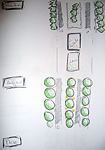



![People promenading on Rothschild Blvd and Herzl St, drawing by Nahum Gutman [1]](/images/thumb/6/6d/Rothschild-Blvd_Herzl_St.jpg/150px-Rothschild-Blvd_Herzl_St.jpg)
![Tel Aviv's first kiosk on the corner of Rothschild Blvd / Herzl St, photo by Avraham Soskin, 1910 [2]](/images/thumb/9/9f/Rothschild-Blvd_1910.jpg/150px-Rothschild-Blvd_1910.jpg)
![Rothschild Blvd and Herzl St, Tel Aviv, 1911 (to the southwest). Note the kiosk under the red arrow. [3]](/images/thumb/f/f1/Rothschild-Blvd_1911.jpg/150px-Rothschild-Blvd_1911.jpg)
![Buildings under construction on Rothschild Blvd [4]](/images/thumb/4/4f/Rothschild-Blvd_construction.jpg/150px-Rothschild-Blvd_construction.jpg)
![Rothschild Blvd towards Neve Tzedek neighborhood, 1921 [5]](/images/thumb/c/c7/Rothschild-Blvd_1921.jpg/150px-Rothschild-Blvd_1921.jpg)
![Rothschild Blvd in the 1920s [6]](/images/thumb/2/2c/Rothschild-Blvd_1920s.jpg/150px-Rothschild-Blvd_1920s.jpg)
![Rothschild Blvd in the 1930s [7]](/images/thumb/e/e5/Rothschild-Blvd_1930s.jpg/150px-Rothschild-Blvd_1930s.jpg)
![Rothschild Blvd, 1947 [8]](/images/thumb/6/60/Rothschild-Blvd_1947.jpg/150px-Rothschild-Blvd_1947.jpg)


![Future scenario of Rothschild Blvd until 2020 [9]](/images/thumb/0/0c/Rothschild.jpg/150px-Rothschild.jpg)
![Model of Meier Tower on Rothschild Blvd / Allenby St (currently under construction) [10]](/images/thumb/c/c1/2047_meier-on-rothschild.jpg/150px-2047_meier-on-rothschild.jpg)




























